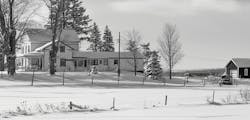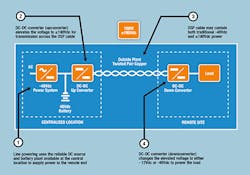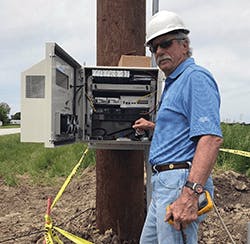No Longer Powerless
Fixed Wireless Access Brings Broadband to Rural Communities —
Imagine living in a rural community on the outskirts of a major metropolitan area. You work at home, so high-speed Internet is a need, not a want. Unfortunately, the ADSL2+ wireline broadband that originates from the Serving Central Office located 2 miles away provides you 2.7 Mbps on a good day. Switching to cable is not an option because your community is served by a co-op that doesn’t offer high-speed Internet. You continue to hope for breakthroughs from the wireless service providers, while recognizing that 1 bar of LTE service just doesn’t get it done. You are willing to pay for broadband, but like so many others in rural communities, you find yourself on the wrong side of the digital divide.
But there is good news on the horizon! Fixed Wireless Access (FWA), an economical, point-to-point wireless technology, is beginning to fill the void in rural America. Entrepreneurs, known as Wireless Internet Services Providers (WISPs), and CAF-incentivized carriers are both using fixed wireless to reach consumers in locations that are too sparsely populated to be economically served with FTTH, DSL, 4G/LTE or 5G networks. Using point-to-point wireless technology for the Last Mile (or miles) connection to the home, these providers are boasting of speeds in excess of 25 Mbps.
The network consists of a few tower-mounted radios that beam unobscured line-of-sight signals over unlicensed spectrum between the radio at the tower and a small antenna located at a customer’s home. The towers usually connect back to the network with fiber, though microwave is an alternative. And to power all the electronic devices, the tower needs access to electricity.
This last requirement — access to power — is the same problem that has been an issue for other distributed networks like DSL, G.fast, and small cells. Most people, including some network builders, assume that electricity is available everywhere. But often, the power is not where it is needed. In those instances, getting power to the site requires some form of utility construction project, which can be prohibitively expensive. Fortunately, inventive service providers have come up with different ways to solve the power problem.
Sites Close to the Grid
When the power grid is near the tower location, it may be economical to have the electrical utility company install a drop to the site. They run the cable, install a meter along with a disconnect switch, and electricity is available for use. The FWA radios may be AC- or DC-powered. While it is possible to energize AC-powered fixed wireless radios directly from the utility power connection, the radio will then be subjected to the frequent sags and surges of the electrical grid. Even for desperate rural customers, high-speed Internet that frequently drops due to recurring service interruptions would not be very desirable.
Rather than connecting radios directly to the utility company’s power service, many service providers equip the site with a power conversion device such as an Uninterruptible Power Supply (UPS) system for AC radios or rectifier for DC versions. In addition, they include some amount of built-in battery reserve to minimize the effects of these interruptions. A minimal battery reserve (e.g., 15 minutes) can provide a buffer to ride through short-term grid outages. Since the overwhelming number of outages are less than a few minutes, this approach helps avoid nuisance interruptions and dissatisfied customers.
InvisiLight® Solution for Deploying Fiber
April 2, 2022Go to Market Faster. Speed up Network Deployment
April 2, 2022Episode 10: Fiber Optic Closure Specs Explained…
April 1, 2022Food for Thought from Our 2022 ICT Visionaries
April 1, 2022The 15-minute reserve also allows the service provider to assess the scope of the problem. If a single site is down, they may dispatch a technician to troubleshoot the situation. If multiple sites are down, they may presume that there is an issue with the area’s electrical grid. In those cases, the provider may not dispatch technicians since the customer’s premises are without power as well.
The radio equipment and other electrical devices at the tower do not consume a lot of power, usually no more than 600W. Even allowing for battery recharge and future sectors, most providers use a small UPS on the order of 900-1200 Watts. Some WISPs provide extended battery backup to further differentiate their service. By equipping the site with 2-4 hours of backup, they can withstand all but the most catastrophic outages and still maintain service. End users with homes or businesses equipped with generators can remain online, even during these more prolonged incidents.
Utility Power Is Not Always Available
Often, the tower sites are too far from the grid to justify the expense of an electrical utility construction project. In a rural environment the tower could be installed in a field or at the back of a property. In those situations, obtaining a drop from the electrical utility to the tower can be prohibitively expensive, and, depending on distance and terrain, it could take a long time to complete. Moreover, the electrical utility may not share the same sense of urgency as the wireless service provider, so even getting the project scheduled could delay turn up dates and complicate logistics.
Some regulated service providers have taken matters into their own hands, electing to use a different powering method that is far less dependent on the electrical utility. This alternative, called Remote Line Power, only requires access to the power grid at a centrally located site. From there, the electricity is converted from AC to DC, then distributed via twisted-pair copper cables to deliver power to multiple towers as far as 21kft away. The interface to the utility company is minimized, but the trade-off is that the service provider must have access to copper cables that run to each of the towers.
Because of their existing infrastructure, regulated service providers (telcos) are more likely than WISPs to use this technique. Central Offices, remote huts, or even repurposed Digital Loop Carrier cabinets, are all ideal candidates for the centralized power site. Each of these sites typically has access to copper cables that can be used to deliver the power to the sites. With the carrier’s expertise in copper cable management, installation, and troubleshooting, there is usually a short learning curve to understanding Remote Line Power for Fixed Wireless applications.
How Does Remote Line Power Work?
At the central site, AC electricity is converted to -48Vdc using a conventional rectifier system. Battery backup may also be provided. The output of the rectifiers connects to an Up-converter, a special DC-DC converter that elevates the voltage to ±190Vdc for transport over the copper cables. For safety, industry standards limit the total power per circuit to 100W. At the tower site, another special DC-DC converter, called a Down-converter, changes the voltage back to -48Vdc to power the radio equipment. Figure 1 shows a block diagram of the operation.
Figure 1. Remote Line Power Block Diagram
Since the total power consumption at the tower may be up to 600W, multiple RLP circuits are needed to supply sufficient power. The cable pairs needed for these circuits often come from abandoned communications cables that were formerly used for POTS or DSL service. In order to convert them for use as power cables, the service provider pre-qualifies the cable pairs to ensure they meet the requirements.
The pre-qualification requires 4 simple tests: foreign DC voltage, foreign AC voltage, insulation resistance, and DC loop resistance. These tests are defined in ATIS-0600030.2016, "Line-Powering of Telecommunications Equipment on Outside Plant (OSP) Copper Twisted Pair Loops." The pre-qualification testing is mandatory to ensure a timely and cost-effective installation. But, as a rule of thumb, cables recently used for POTS or DSL service will usually qualify for Remote Line Power.
In situations where the existing copper cables do not reach all the way to the tower, the service providers deploy new composite cables from the last splice point to the tower. With a common sheath, the labor cost is minimized because the fiber has to be installed regardless. The copper and fiber are run at the same time, minimizing the cost of labor.
Figure 2. Alpha’s Tony Wilson at the first Remote Line Powered FWA Installation.
In either the local or remote power arrangements, an outside plant cabinet is installed at the tower site to house the UPS/rectifier, batteries, and other ancillary equipment. Like with other services, the cabinets must withstand the outdoor conditions. They may be either pole- or pad-mounted. For the Remote Line Power applications, there is also a modular down-converter system to change the voltage back to -48Vdc. One of the first Remote Line Power cabinets installed for Fixed Wireless is shown in Figure 2.
Tony Wilson, Director of Sales for Alpha Technologies, has been involved in the trials and early deployments for both WISPs and service providers. "The WISPs have been the entrepreneurs and pioneers in this area, but the LECs have quickly recognized the rewards and advantages of their embedded copper infrastructure," said Tony. "There have been some challenges as they tackle unchartered territory, but they’re learning quickly that if you wait for all the lights to turn green, you will never leave town."
A Sweet Spot
The local power solution is the sweet spot for WISPs since most do not have existing telecom infrastructure for Remote Line Power solutions. This has not hindered them in leading their efforts to upgrade broadband services for rural communities. According to the Wireless Internet Service Providers Association (http://www.wispa.org), the industry "delivers broadband Internet to over 3 million users via 3,000+ Internet Service Providers (ISPs) that serve both residential and business customers, often in exclusively rural areas."
The regulated carriers are more likely to use Remote Line Power. Minimizing the logistics with the electrical utility enables them to scale quicker. In addition, they can leverage existing assets while adding new customers or new services.
Fixed Wireless Access may check all the boxes: bandwidth-starved customers, economical wireless technology, available spectrum, and high capacity fiber to backhaul the service. With the power problems resolved, FWA provides both entrepreneurs and regulated providers with an intriguing business proposition that fills a long overdue service gap. The service can go a long way toward helping the rural community bridge the digital divide.
About the Author







